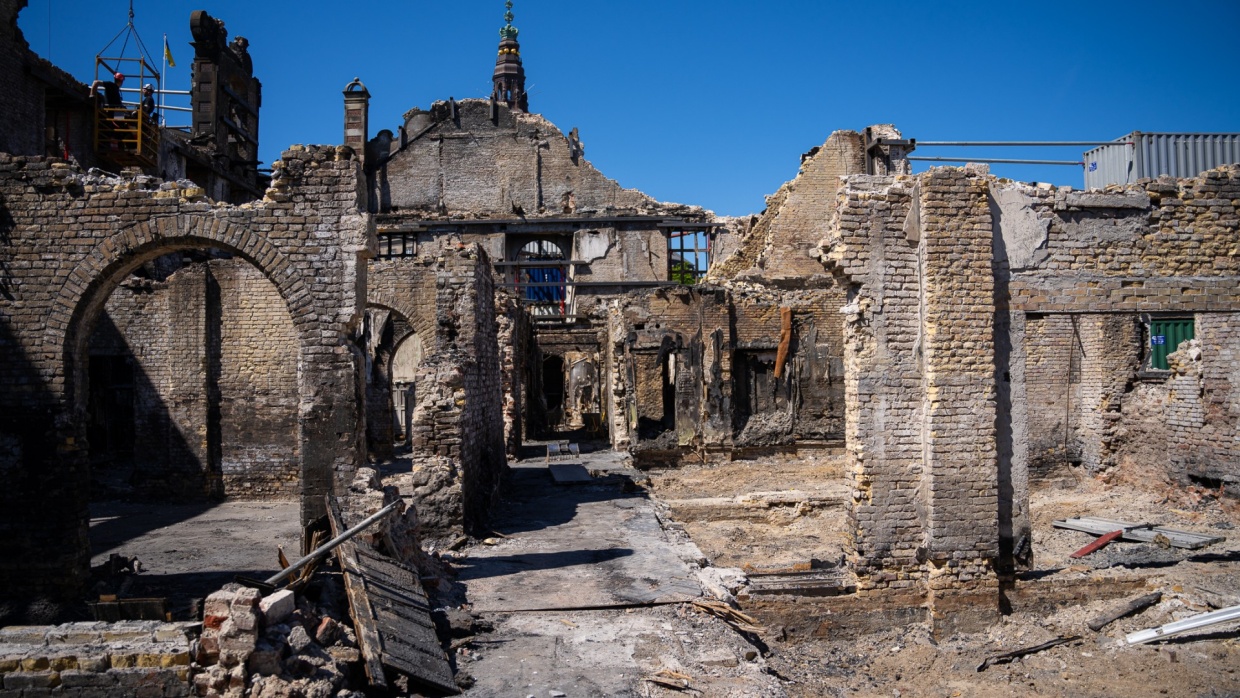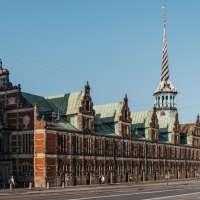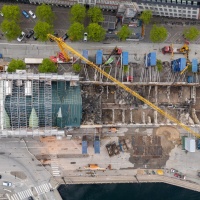News
News
Tensions of the Present: The Cultural Heritage of Copenhagen Stock Exchange after the Fire
The fire at the Old Stock Exchange in Copenhagen destroyed 55 percent of a national landmark. The reconstruction work that is now beginning reflects a familiar debate about the preservation of historical monuments under new, complex circumstances: how can the reconstruction of a historic building be reconciled with calls for a halt to construction on grounds of sustainability? Two voices—that of the owner, the Danish Chamber of Commerce, and that of architect and professor of sustainable building culture Nicolai Bo Andersen—show that cultural heritage and the climate crisis must be balanced in Copenhagen.
“Does your call for a moratorium on all new construction also apply to the reconstruction of the stock exchange?” When Nicolai Bo Andersen, professor of sustainable building culture at the Royal Danish Academy, hears this question, he laughs. “Of course,” he replies. And immediately adds: “But that doesn't change the fact that the stock exchange has to be rebuilt.”
This brief moment encapsulates all the ambivalence surrounding the reconstruction — or rather, the new construction — of the 400-year-old building. On the one hand, the Old Stock Exchange, located not far from Christiansborg Palace in the heart of Copenhagen, represents Denmark's national identity and its trading history. On the other hand, following the devastating fire on 16 April 2024, it can now be cited as a prime example of how monument conservation, sustainability, and climate justice may be reconciled.
A cultural, an identity shaping heritage
For the Danish Chamber of Commerce, which has owned the Old Stock Exchange since 1857, the answer is clear. “The building is a big part of our identity,” says Christian Sestoft, the chamber's project manager responsible for rebuilding the stock exchange. “It was the center of trade and commerce for 400 years – and should remain so for the next 400 years.”
Only nine days after the fire, The National heritage authority announced that the building will remain a listed building, due to the building's unique architectural qualities, its significant cultural-historical significance and the fact that 45 pct. is still preserved.
The Chamber of Commerce is financing the reconstruction without government support. This is made possible by the insurance company, which has recognized the fire as a claim. The reconstruction requires approval from the conservation authorities. The expectation is that the rebuilding will take a form that more closely reflects the building’s original structure, as the many alterations over time had weakened the building both structurally and architecturally.
The challenge in rebuilding the stock exchange thereby is that there is no real, clearly definable original condition. According to Christian Sestoft, the exterior of the reconstruction will correspond to its latest state, while the interior will be more closely based on the original plans from the time of Christian IV. The 886 pine trees used for the rebuilding will to ensure authenticity come from Christian IV’s old kingdom, which includes the Swedish island Gotland. The interior of the stock exchange will also not look the same after it reopens as it did on the day before the fire. Inside, the large hall on the upper floor is to be restored, among other things.
“No new building is sustainable”
The conversation with Christian Sestoft shows how important the reconstruction of the Danish Stock Exchange is. Not only for the Chamber, but for Denmark and its population as a whole. However, Nicolai Bo Andersen raises a fundamental question in this context: What can we still afford to build in times where seven out of nine planetary boundaries – such as climate change, biosphere integrity or land system change – have been breached?
“The construction sector accounts for one-third of all European energy-related emissions and consumes up to half of all materials,” he explains. No building constructed today can seriously be considered sustainable. Instead, he advocates for a moratorium: most new construction in the Western world should be suspended, while existing buildings should be better utilized, carefully restored, and transformed as far as possible.
This demand stems not only from ecological calculations, but also from an ethical stance. In his article “Space Justice,” Andersen argues: if we continue to expand the build space on a limited planet, this will be at the expense of others—especially future generations. “Architects must learn to work with what already exists,” says Andersen.
And yet he does not oppose the reconstruction of the stock exchange. His position: cultural heritage has a special status because its significance extends far beyond mere square meters. In his text “After the Fire,” he argues that precisely because the stock exchange has been changing for centuries, its reconstruction must be understood as part of this development—but with a strategy that focuses on reuse, careful documentation, and respect for all layers of time. Andersen writes: “I propose a ‘less clean’ approach that reuses as much original material as possible and respects the best of the different eras.” This approach is also in line with the history of the stock exchange, which is not absolute, but is characterized by its constant change.
Christian Sestoft emphasizes that efforts are being made to incorporate sustainability wherever possible: right now, bricks from the ruin are being cleaned for reuse in the building, and the destroyed copper roof has been sent for recycling in Finland.
Between heritage and future
Andersen thus touches on a core issue in monument conservation: what actually constitutes “the original”? The Old Stock Exchange has undergone several profound renovations in its 400-year history. For instance, the façade was renovated with new brick tiles at the end of the 19th century, fundamentally changing its appearance.
While the reconstruction of Notre Dame in Paris—with an almost exact reconstruction of the condition immediately before the fire—was comparatively “simple,” the situation in Copenhagen is more complex. Here, the aim is not only to restore a lost condition, but to continue the story of a multi-layered building.
In international exchanges, for example with the restoration teams at Notre Dame in Paris or with representatives of the Leipzig Chamber of Crafts, the Danish Chamber of Commerce is seeking answers as to how reconstruction can be successful in the 21st century.
And perhaps it is precisely this contradiction that makes the stock exchange a symbol: it will once again be considered “historic,” even though it is partly a new building. It will consume energy and raw materials, but at the same time it is part of a tradition that can also be used as inspiration for more sustainable construction.
“It is not the unity of style that is decisive,” writes Andersen, “but the overall effect, the atmosphere that moves us and makes us aware that we are part of a larger narrative.” This is entirely in line with a statement he made during a telephone conversation. For the large story that humanity must write seems to be today how it deals with the onset of climate catastrophe. Andersen's approach, also in teaching his students, is to learn from the knowledge of old buildings. For sustainability and respect for planetary boundaries can often already be found within their walls. With the climate catastrophe already underway, it is important today to relearn this knowledge. He says: “For me, cultural heritage is a source of inspiration for a sustainable building culture of the future.” The reconstruction—or rather, the partly new construction—of Copenhagen's Old Stock Exchange seems to have been initiated with this mindset. As contradictory as that may seem.







